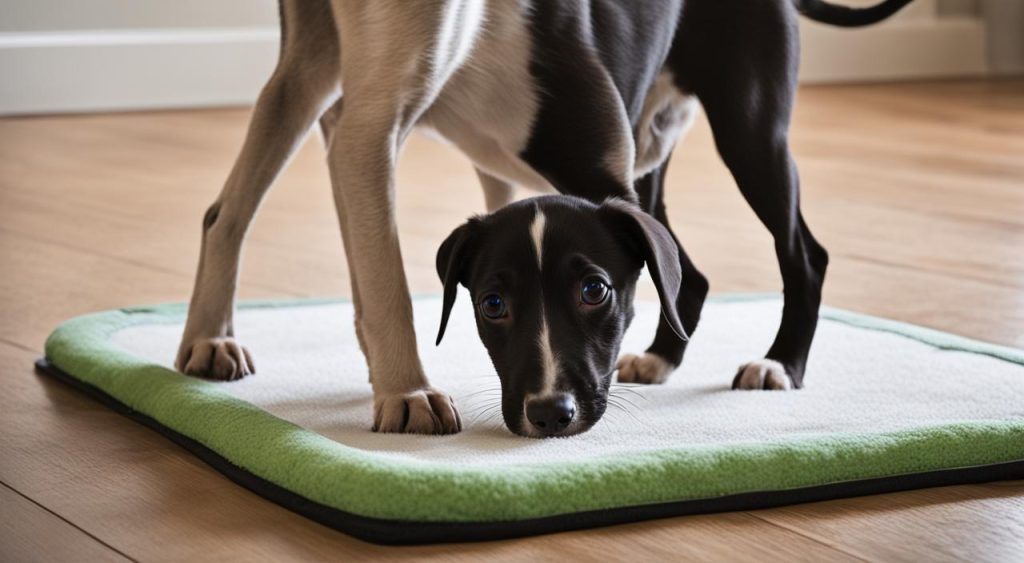Whippets, like any other dog breed, have their unique ways of communicating with their owners. One of the behaviors commonly seen in Whippets is whining. Whining can be a vocal expression of various emotions and needs, and understanding why Whippets whine can help you address this behavior effectively.
Whippets may whine for different reasons, including boredom, attention-seeking, discomfort, or anxiety. They may express their desire for something, such as food or access to a specific space, through whining. Additionally, Whippets may whine when they feel anxious or need attention. It is crucial to recognize the underlying cause behind their whining to provide appropriate care and training.
Key Takeaways:
- Whippets whine to communicate their needs and emotions.
- Boredom, attention-seeking, discomfort, or anxiety can trigger whining in Whippets.
- Understanding the reasons behind whining can help you address and manage the behavior effectively.
- Providing mental and physical stimulation, addressing discomfort or pain, managing separation anxiety, and training alternative behaviors can help reduce whining in Whippets.
- Seeking professional assistance may be beneficial in cases of severe separation anxiety or complex behavioral issues.
Common reasons for Whippet whining
Whippets may whine for a variety of reasons, and understanding these common triggers can help address their whining behavior effectively.
Boredom and lack of stimulation
One reason why Whippets may whine is due to boredom. These active and intelligent dogs require mental and physical stimulation to stay engaged and happy. When they don’t receive enough exercise or mental enrichment, they may resort to whining as a way to express their boredom.
Separation anxiety
Another common cause of whining in Whippets is separation anxiety. These dogs form strong bonds with their owners and can become distressed when left alone. Whining can be a manifestation of their anxiety and desire for companionship.
Discomfort or pain
If your Whippet is experiencing discomfort or pain, they may express it through whining. It’s crucial to pay attention to any signs of physical discomfort, such as limping, licking certain areas, or changes in appetite, alongside their whining behavior.
Attention-seeking
Whippets are social animals and may resort to whining as a means of seeking attention from their owners. If they have learned that whining leads to attention or rewards, they may continue this behavior as a communication strategy.
Fear or anxiety
Whining can also be a sign of fear or anxiety in Whippets. They may whine when they encounter unfamiliar situations, loud noises, or express their apprehension towards certain people or objects. It’s essential to create a safe and comforting environment for Whippets to help alleviate their anxiety.
Desire for something
Whippets may also whine when they want access to something they desire, such as food, water, or a specific space. Whining can be their way of communicating their needs and preferences.
By identifying the specific reason behind your Whippet’s whining, you can implement appropriate strategies to address the underlying cause. Whether it’s providing more mental and physical stimulation, managing separation anxiety, addressing discomfort, or using positive reinforcement training methods, understanding the reasons behind their whining can lead to better communication and a happier Whippet.
Addressing Whippet Whining Caused by Boredom
Whippets are active and intelligent dogs that require mental and physical stimulation to prevent boredom. Whining can be a sign of boredom in Whippets.
To address this, provide your Whippet with regular exercise and playtime. Engage them in interactive toys, puzzles, and games that stimulate their mind.
Incorporating obedience training and teaching new commands can also help keep their minds engaged and reduce boredom-induced whining.
Establish a consistent schedule for activities and ensure your Whippet gets enough mental and physical stimulation throughout the day.
Managing Whippet Whining Caused by Discomfort or Pain
Whippets may whine when they are experiencing discomfort or pain. If you suspect that your Whippet’s whining is related to physical discomfort, it is essential to consult with a veterinarian to rule out any underlying health issues.
Once any medical concerns have been addressed, you can manage their whining by ensuring their physical needs are met. Provide a comfortable resting space for your Whippet to alleviate any discomfort they may be experiencing. Make sure their bed or crate is cozy and supportive to help them relax.
Additionally, pay close attention to their diet. Monitor their food intake and consider if they have any food sensitivities that could be causing discomfort or digestive issues. A balanced and appropriate diet can contribute to their overall well-being and reduce whining caused by discomfort.
Regular grooming is also crucial for preventing skin irritations, which can cause your Whippet to experience discomfort. Keep their coat clean and free from any matting or irritation. Check their paws for any foreign objects or signs of injury.
By taking proactive steps to keep your Whippet comfortable, you can help alleviate whining caused by physical discomfort or pain. Remember, your veterinarian is your best resource for diagnosing and managing any underlying health issues. Always consult with them for guidance on your Whippet’s specific needs.
Coping with Whippet Whining Due to Separation Anxiety
Whippets are known to be prone to separation anxiety, which can result in excessive whining when they are left alone. Coping with Whippet whining caused by separation anxiety requires a combination of gradual acclimation, positive reinforcement training, and providing mental stimulation.
To help your Whippet cope with separation anxiety, start by gradually acclimating them to being alone. Begin with short periods of time and gradually increase the duration as they become more comfortable. This helps build their confidence and reduces anxiety.
Using positive reinforcement training techniques can also encourage calm behavior when you leave and return. Reward your Whippet for remaining calm and quiet, reinforcing the idea that being alone is a positive experience.
Another way to manage separation anxiety-related whining is by keeping your Whippet mentally stimulated during your absence. Provide them with interactive toys or puzzle feeders that can keep their minds engaged and distracted from their anxiety.
For Whippets with severe separation anxiety, you may consider using calming aids such as pheromone diffusers or herbal supplements. These can help create a more relaxing environment and reduce their anxiety levels. Consult with your veterinarian for recommendations tailored to your Whippet’s specific needs.
Additionally, seeking professional assistance from a dog trainer or behaviorist experienced in separation anxiety can provide valuable guidance and develop a customized management plan. They can offer strategies and techniques to address your Whippet’s specific needs and help alleviate their separation anxiety.
By gradually acclimating your Whippet, using positive reinforcement training, providing mental stimulation, and seeking professional assistance when necessary, you can effectively cope with Whippet whining caused by separation anxiety. With patience and consistency, you can help your Whippet feel more secure and reduce their excessive whining.
Dealing with attention-seeking whining in Whippets
If your Whippet is resorting to attention-seeking whining, it’s essential to address this behavior promptly and effectively. Attention-seeking whining can be a challenging behavior to deal with, but with consistent training and patience, you can teach your Whippet healthier ways to seek attention.
First and foremost, it’s important to avoid reinforcing the attention-seeking whining. When your Whippet starts whining for attention, resist the urge to give in and provide immediate attention. Instead, ignore the whining completely.
Using positive reinforcement training methods, you can teach your Whippet alternative behaviors that are more desirable when seeking attention. For example, you can train them to sit or lie down quietly to get your attention. When your Whippet displays the desired behavior, reward them with praise, treats, or affection.
“By rewarding your Whippet for calm and quiet behavior, you are reinforcing and encouraging the right behaviors while discouraging attention-seeking whining.”
Consistency is key in dealing with attention-seeking whining. Be patient and make sure everyone in your household follows the same approach. It may take time for your Whippet to understand that whining does not lead to attention, but staying consistent will help them learn the new behavior.
Additionally, providing plenty of mental and physical stimulation for your Whippet can help prevent attention-seeking whining. Engage your Whippet in regular exercise, playtime, and interactive toys to keep them mentally and physically stimulated throughout the day. A tired, well-exercised Whippet is less likely to engage in attention-seeking behaviors.
Remember, it’s essential to remain calm and avoid getting frustrated or scolding your Whippet when they exhibit attention-seeking whining. Patience, consistency, and positive reinforcement are key in helping your Whippet learn appropriate ways to seek attention and reducing attention-seeking whining behavior.
Training alternative behaviors to replace whining
When it comes to managing whining behavior in Whippets, training alternative behaviors can be highly effective. By teaching your Whippet new ways to communicate their needs, you can replace whining with more appropriate behaviors. One method you can employ is teaching your Whippet to ring a bell or touch a specific object to signal their need to go outside or get water.
This redirection of their communication allows them to express themselves without resorting to whining. Consistency is key in this training process. By reinforcing and rewarding the desired behaviors, such as touching the object or ringing the bell, you can encourage your Whippet to use these alternative methods instead of whining.
Remember to be patient and persistent throughout the training process. Repetition and positive reinforcement will help your Whippet understand and internalize the new behaviors. Over time, they will learn to communicate their needs in a more appropriate and effective manner, reducing their reliance on whining.
Providing Environmental Enrichment to Reduce Whippet Whining
Whippets are energetic and intelligent dogs that thrive in environments that provide mental and physical stimulation. By enriching their environment, you can help reduce whining behavior and promote their overall well-being.
One way to provide environmental enrichment for your Whippet is by offering a variety of toys and activities that keep them engaged and entertained. Choose toys that are interactive and mentally stimulating, such as puzzle toys or treat-dispensing toys. These toys will challenge your Whippet’s problem-solving skills and help keep their minds occupied, reducing the likelihood of whining out of boredom.
It’s also essential to rotate the toys regularly to keep your Whippet’s interest levels high. When they have access to new and exciting toys, they are less likely to engage in excessive whining behavior, as they have a positive outlet for their energy and curiosity.
“Toys that provide a challenge and reward system, such as puzzle toys or treat-dispensing toys, can be particularly beneficial in reducing whining behavior.”
In addition to toys, creating specific spaces where your Whippet can feel safe and comfortable is crucial. Designate a cozy bed or create a den-like area that allows your Whippet to retreat when they need some downtime. This space should be quiet, free from distractions, and equipped with comfortable bedding to ensure your Whippet feels secure and relaxed.
Environmental enrichment not only helps prevent boredom but also provides a sense of security and mental stimulation for your Whippet. This can significantly reduce whining behavior, as they have outlets for their energy and natural instincts.
Remember, every Whippet is unique, so it’s essential to observe and understand your individual dog’s preferences and needs. By providing the right environmental enrichment tailored to your Whippet, you can create a stimulating and fulfilling environment that reduces whining behavior and promotes a happy and contented dog.
Using Professional Assistance for Whippet Whining
If you are facing challenges in addressing your Whippet’s whining behavior, seeking professional assistance can be highly beneficial. A certified Whippet behaviorist or trainer with experience in working with Whippets can provide expert guidance and develop a tailored training plan to target whining issues, particularly in cases of separation anxiety or complex behavioral problems.
By enlisting the help of a Whippet behaviorist, you can expect a comprehensive assessment of your Whippet’s specific needs, enabling the development of effective strategies to manage and modify their whining behavior. These professionals possess the knowledge and experience to determine the root causes of whining and provide you with the tools and techniques to address them.
“A qualified dog behaviorist or trainer experienced in working with Whippets can provide guidance and develop a tailored training plan to address whining issues, especially in cases of separation anxiety or complex behavioral problems.”
Working with a Whippet behaviorist or trainer can bring valuable insights and expertise to your training efforts. They can help you navigate challenging behaviors such as separation anxiety, provide targeted advice on training exercises, and offer support throughout the process of modifying your Whippet’s behavior.
Remember, seeking professional assistance is not a sign of failure. It is a proactive step towards ensuring the well-being and happiness of your Whippet. With the guidance of a Whippet behaviorist or trainer, you can gain the knowledge and skills needed to effectively manage and train your Whippet, leading to a healthier and more harmonious relationship.
Realistic timeline for reducing Whippet whining
The timeline for reducing Whippet whining can vary depending on several factors, including the underlying cause, the severity of the whining behavior, and the consistency of the training and management techniques employed. While each Whippet is unique, with proper training and management, you can expect to observe improvements in their whining behavior within a few weeks or months.
It is important to recognize that addressing separation anxiety or complex behavioral problems associated with whining may require a longer-term commitment and ongoing training. Patience and consistency are key when working with Whippets and managing their separation anxiety. It is crucial to establish a strong foundation of trust and provide them with a secure environment to gradually reduce their whining behavior over time.
Reassuring Whippets without reinforcing anxiety
When your Whippet is whining due to fear or anxiety, it is important to provide them with calm and soothing verbal reassurance.
“Whippets, like many dogs, can experience anxiety and may resort to whining as a way to express their distress.”
Avoid rewarding or giving excessive attention to the whining behavior itself, as this can reinforce the anxiety. Instead, focus on creating a calm and supportive environment for your Whippet.
Creating a calm environment
By creating a calm environment, you can help alleviate your Whippet’s anxiety without reinforcing their whining. Ensure that their space is comfortable and free from any potential stressors.
Eliminate loud noises or abrupt movements that may trigger their anxiety. Establish a routine and provide structure, as Whippets thrive on consistency.
Patience, consistency, and positive reinforcement
Patience is key when reassuring your Whippet. Avoid getting frustrated or impatient with their whining, as this may exacerbate their anxiety.
Consistency in your approach is also important. Stick to a regular feeding and exercise schedule, and provide your Whippet with plenty of mental and physical stimulation to help reduce their anxiety levels.
Use positive reinforcement to reward calm behavior. When your Whippet is quiet and relaxed, offer treats, praise, or affection to reinforce their calmness. This will help them associate calm behavior with positive rewards and further reduce their anxiety.
Remember, it takes time for your Whippet to overcome anxiety and learn to cope without resorting to whining. By providing reassurance, creating a calm environment, and using positive reinforcement, you can comfort your Whippet while helping them overcome their anxiety.
The possibility of resolving Whippet separation anxiety
With dedication, proper training, and management, it is possible to greatly improve and even resolve Whippet separation anxiety.
Working with a qualified and experienced separation anxiety trainer can help you develop a structured training plan to gradually increase your Whippet’s tolerance for being alone.
“
Many Whippets have successfully overcome their separation anxiety with the right approach.”
Although it may be a long process, resolving Whippet separation anxiety is achievable with the right approach and effort.
Remember that consistency, patience, and a supportive environment are key to resolving Whippet separation anxiety.
Conclusion
Whippet whining can be a common behavior that owners encounter. However, understanding the reasons behind their whining is crucial for effective management. Whippets may whine due to boredom, discomfort, separation anxiety, or attention-seeking. By addressing these underlying causes, providing environmental enrichment, training alternative behaviors, and seeking professional assistance when needed, you can reduce and manage their whining behavior.
Addressing whippet whining caused by boredom involves providing regular exercise, mental stimulation, and a consistent schedule for activities. Additionally, managing discomfort or pain entails consulting a veterinarian and ensuring their physical needs are met. Coping with separation anxiety may involve gradual acclimation and the use of calming aids, while attention-seeking whining can be discouraged through consistent ignoring and positive reinforcement training.
Training alternative behaviors to replace whining, providing environmental enrichment, and seeking professional assistance are additional strategies that can be employed to reduce Whippet whining. By being patient, consistent, and supportive throughout the training process, you can effectively manage your Whippet’s whining behavior and help them communicate their needs in healthier ways.





